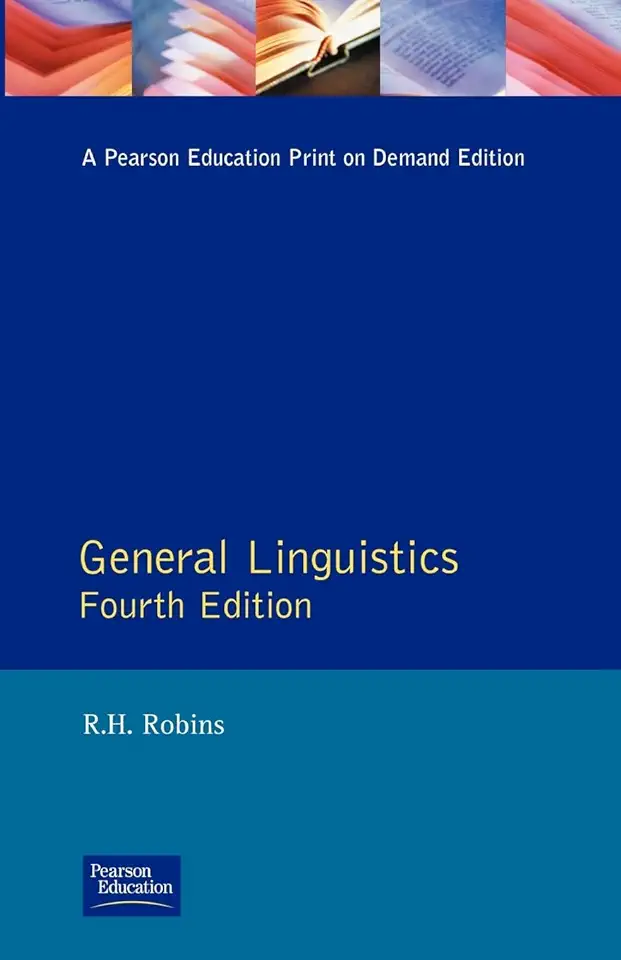
General Linguistics: An Introductory Survey - R. H. Robins
General Linguistics: An Introductory Survey by R. H. Robins
A Comprehensive Guide to the Study of Language
In "General Linguistics: An Introductory Survey," renowned linguist R. H. Robins provides a comprehensive and accessible introduction to the field of linguistics. This seminal work offers a thorough exploration of the fundamental concepts, theories, and methods used in the scientific study of language.
Key Features:
Comprehensive Coverage: Robins covers a wide range of topics, including phonetics, phonology, morphology, syntax, semantics, and pragmatics, providing a well-rounded understanding of the different aspects of language.
Clear and Engaging Writing Style: Robins presents complex linguistic concepts in a clear and engaging manner, making the book accessible to both students and general readers alike.
Historical Perspective: Robins provides a historical context for the development of linguistic theories, tracing their evolution and highlighting the contributions of key figures in the field.
Examples and Exercises: The book is enriched with numerous examples and exercises, allowing readers to apply their knowledge and reinforce their understanding of the material.
Why You Should Read This Book:
Gain a Solid Foundation in Linguistics: "General Linguistics" serves as an excellent starting point for anyone interested in pursuing further studies in linguistics or related fields.
Enhance Your Communication Skills: By understanding the intricacies of language, you can improve your communication skills and become more effective in expressing yourself.
Broaden Your Perspective: Studying linguistics offers a unique perspective on human cognition, culture, and society, enriching your understanding of the world around you.
Enjoy the Intellectual Journey: Robins' passion for linguistics shines through in his writing, making the reading experience both informative and enjoyable.
Don't miss out on this opportunity to delve into the fascinating world of language! Get your copy of "General Linguistics: An Introductory Survey" today and embark on an intellectual journey that will broaden your horizons and deepen your understanding of human communication.
Topics Covered:
1. Phonetics and Phonology:
- The study of speech sounds and how they are produced.
- Analysis of sound patterns and their organization in languages.
2. Morphology:
- The study of word formation and the internal structure of words.
- Identification of morphemes, the smallest meaningful units of language.
3. Syntax:
- The study of sentence structure and the rules governing word combinations.
- Analysis of grammatical relationships and sentence patterns.
4. Semantics:
- The study of meaning in language.
- Examination of how words and sentences convey ideas and concepts.
5. Pragmatics:
- The study of language use in context.
- Analysis of how language is influenced by social and cultural factors.
Theories and Methods:
1. Structuralism:
- A dominant approach in linguistics during the mid-20th century.
- Emphasis on the analysis of language as a system of interconnected elements.
2. Generative Grammar:
- A theory of language acquisition and production developed by Noam Chomsky.
- Focus on the underlying rules that govern sentence formation.
3. Functionalism:
- An approach that emphasizes the communicative function of language.
- Analysis of how language is used to achieve specific purposes.
4. Cognitive Linguistics:
- A field that explores the relationship between language and cognition.
- Investigation of how language reflects and shapes our mental processes.
Applications of Linguistics:
1. Language Teaching and Learning:
- Linguistics provides insights into effective language teaching methods.
- Understanding linguistic structures aids in language acquisition.
2. Language Documentation and Preservation:
- Linguistics contributes to the documentation and preservation of endangered languages.
- Linguistic analysis helps in language revitalization efforts.
3. Natural Language Processing:
- Linguistics plays a crucial role in developing technologies for understanding and generating human language.
- Applications include machine translation, speech recognition, and chatbots.
4. Forensic Linguistics:
- Linguistics is used in legal contexts to analyze written and spoken language for evidence.
- Applications include authorship attribution, speaker identification, and discourse analysis.
5. Sociolinguistics:
- The study of the relationship between language and society.
- Analysis of language variation, language attitudes, and language policy.
6. Psycholinguistics:
- The study of the psychological processes involved in language comprehension and production.
- Investigation of language acquisition, language disorders, and bilingualism.
Conclusion:
"General Linguistics: An Introductory Survey" by R. H. Robins is an essential resource for anyone seeking a comprehensive understanding of the field of linguistics. Its clear and engaging writing style, combined with its thorough coverage of key concepts, theories, and applications, makes it an invaluable resource for students, scholars, and anyone interested in the study of language.